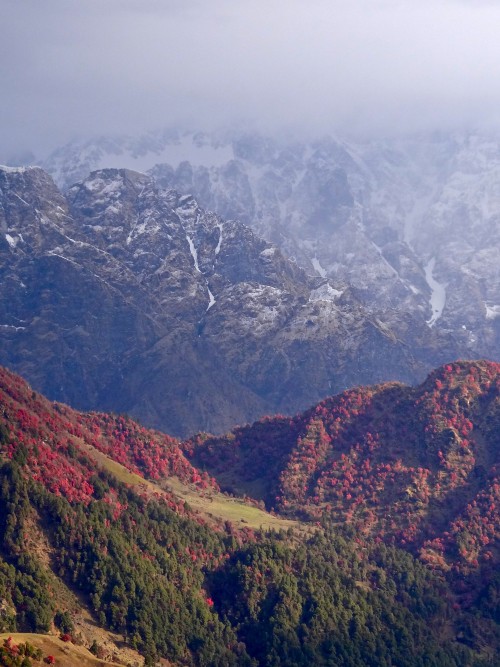
Close your eyes and imagine a mountain. What does it look like? What shape is it?
Most likely you imagined something pyramid-shaped: broad on the bottom, pointy on top, and tapering in between.
If that’s what you envisioned, you’re not alone. Scientists have been describing mountains this way for decades, especially in the context of climate change and its effect on living things.
But now, a new study in the journal Nature Climate Change shows that when you look at whole mountain ranges – like the Rockies or the Himalayas – their shapes are more accurately portrayed as diamonds, hourglasses, or even upside-down pyramids.
This mind-twisting reality, say the authors, could mean a boon for some species but more serious peril for others, as the Earth’s climate continues to change.
“In the natural world, even things we think we know really well, we don’t actually know,” says UConn study author Morgan Tingley. “Most mountains are not in fact pyramids, and this gets to the fundamental assumptions we make, and the impact those assumptions have on conservation.”
Inverted pyramids

The “escalator effect” narrative has dominated studies of mountain climate change, says Tingley, an assistant professor of ecology and evolutionary biology in the College of Liberal Arts and Sciences.
It goes like this: As you climb up in elevation, temperature decreases. So as the Earth warms, species adapted to their current climate must move higher and higher in elevation to stay in those best-adapted conditions. So climate change acts like an escalator, taking species further and further up.
And since, as we assume, there’s a lot less space at the top of a mountain, species get crowded, and are in effect pushed off the escalator into extinction.
In the natural world, even things we think we know really well, we don’t actually know. — Morgan Tingley
But Tingley’s coauthor Paul Elsen, a graduate student at Princeton University, had observed from his experiences traversing mountains in the Himalayan range that natural features like steep slopes, plateaus, and deep ravines can increase or decrease a mountain’s habitable area.
“In the Himalayas, you can hike up a really steep slope to a high elevation, at about 15,000 feet, and reach vast expanses of habitat,” Tingley points out. He notes that anyone who spends time hiking in the mountains has probably had similar experiences.
Using the most comprehensive public data set available on mountain ranges, Tingley and Elsen analyzed the surface area across elevations for 182 distinct mountain ranges on all six inhabited continents.
What they found has turned their idea of mountains literally inside-out: More than two-thirds of all the mountain ranges did not conform to a pyramid shape. Instead, 39 percent had a majority of their area at mid-elevation (a diamond shape), 23 percent had the least amount of their area at mid-elevation (an hourglass), and six percent had most of their area at high elevations (an inverted pyramid).
‘Pinch points’
Tingley says these findings throw a big wrench into theories that depend on an assumed escalator effect.
The Rocky Mountains, for example, are a diamond-shaped range, so animals and plants living in the foothills may actually see an increase in available space as they move up these mountains.
Similarly, species that live at mid-elevation in hourglass-shaped ranges might also find more space at higher elevations. The Himalayan monal, a rooster-sized, rainbow-colored, mysterious pheasant – famous as inspiration for the character Kevin in the Disney/Pixar movie “Up” – currently lives in the middle of the hourglass-shaped Himalayas. So, says Tingley, species like this could benefit from shifting up.

But for other species, such as animals in the foothills of the Himalayas, there may be far less space to move to at the middle of the mountain than higher up, says Tingley. He calls these areas “pinch points.”
“Some species that are at low elevation on hourglass mountain ranges could go through a mid-elevation bottleneck where there’s not as much space,” he says. “If you can make it through the bottleneck, that’s great, but if you’re a species that’s narrowly restricted in its elevation range, you could go extinct before you expand into that higher-elevation space.”
And in the case of inverted pyramid ranges, where most of the area is toward the top, there would be more area for animals and plants as they move upward – until the very top, of course, where all mountains end.
“This completely changes the way we see mountains,” says Elsen. “No one has looked at the shapes of mountain ranges across the entire globe, and I don’t think anyone would expect that only 30 percent of the ranges in the world have this pyramid shape that we have assumed is the dominant shape of mountains. That has been the prevailing image of mountains in the public perception and the scientific perception, and it’s really had a big influence on how scientists think montane species will respond to climate change.”
Tingley says he hopes conservationists will take mountain topography into account when creating species conservation plans. The appendix to the paper classifies all 182 mountain ranges into the four labels, a resource that conservationists can use to make better decisions about priorities for species protection.
“When it comes to conserving species on mountains, we have to be asking: What is the species? Where is it? What is the topography? And importantly, where is that species likely to go?” Tingley says.
He urges conservationists and other scientists to continue to question fundamental assumptions about nature, because, he says, the reality is often surprising: “Simple rules don’t always hold up.”
Watch a MinutePhysics video that summarizes the study’s findings.



